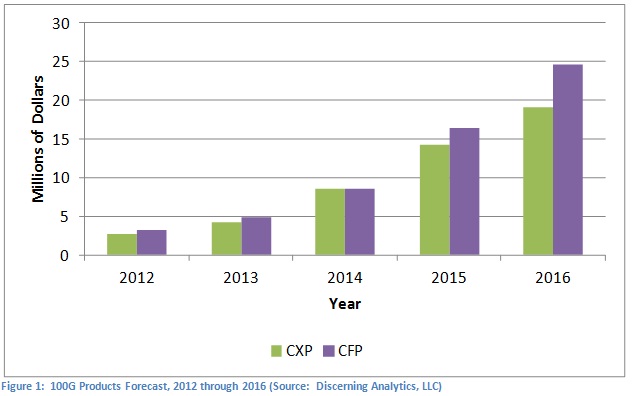By Lisa Huff, Discerning Analytics
Ever since the 40/100G Ethernet standard was completed in 2009, the IEEE standards group has been continuing to refine it. While the original standard covers the minimum requirements, end users have indicated two areas for enhancement:
-
The 40G long-reach variant (40GBASE-LR4) did not match the existing telecom standard for 40G so some type of conversion equipment would be needed. This was addressed when the IEEE 802.3bg 40GBASE-FR single mode fiber standard was released in 2010.
-
The second concern is the 100GBASE variants. Four standardized and one MSA currently exist and are shown in the following table.
For 40/100G, the IEEE task force limited the number of variants based on feedback that there were too many for 10G so fewer should be considered for higher data rates. However, some data center managers are concerned with medium-reach connections. By reducing the laser-optimized multi-mode fiber (LOMF) optical reach to 100m over OM3 and 125m for OM4, the standard leaves a gap in distance covered for data center applications –from 100m to 10km. While more than 90-percent of data center connections are less than 100m that last 10-percent still need to have a cost-effective solution. The 10km variant would typically be used for campus and metro connections so is typically outside a data center’s budget. For example, a 100GBASE-SR10 CXP optical module, with a reach of 100m, has an average selling price of about $200, while the 100GBASE-LR4 CFP module that covers 10km averages a price of more than $20,000. However, several of the top transceiver manufacturers including Avago Technologies (Booth 1357), Finisar (Booth 1703) and JDSU (Booth 1403) are working on SR10 products that have the potential to reach to 300m.
In addition, the Next Generation 100Gb/s Optical Ethernet Study Group, part of the IEEE 802.3 standards development, is now working to address this issue as well. Its charter is to investigate 25G-per-lane standards and to explore lower-cost solutions to cover reaches perhaps up to a kilometer or even more.
Any 100G variant using 25G signaling is still under development and nearing completion. While the optical devices are almost ready to go, there are projects to ascertain how 25G is going to run on a printed-circuit board (PCBs) or on twinax cable. The group that was studying this has just officially been named a task force in the IEEE – the P802.3bj 100 Gb/s Backplane and Copper Cable Task Force. There are chip sets to run 25G signals over PCBs that will be available in the coming months. In fact, Texas Instruments demonstrated this at SC11.
The LR10 variant is not standardized, but is backed by a consortium of vendors and end users – including Google. Whether this will take hold in the industry still remains to be seen, but it could be an interim solution to address the cost differential seen between the current standardized options.
Even though challenges exist, 100G has arrived. The following figure shows the opportunity over the next five years.

Even though we can see Terabit Ethernet is on the horizon, there are opportunities to enhance 100G products in the near term which will fuel its growth in the marketplace.
Posted: 24 February 2012 by
Lisa Huff, Discerning Analytics
| with 0 comments